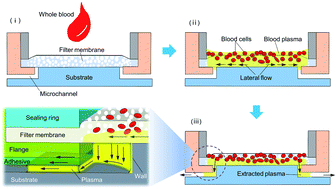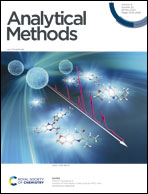A simple and rapid method for blood plasma separation driven by capillary force with an application in protein detection†
Abstract
Blood plasma separation is a vital sample pre-treatment procedure for microfluidic devices in blood diagnostics, and it requires reliability and speediness. In this work, we propose a novel and simple method for microvolume blood plasma separation driven by capillary force. Flat-shaped filter membranes combined with hydrophilic narrow capillaries are introduced into devices, in order to reduce the residual volumes of blood plasma. An interference fit is used to ensure no leakage of blood or cells. There is desired trapping efficiency of blood cells in the devices. The method provides high efficiency with a plasma extraction yield of 71.7% within 6 min, using 60 μL of undiluted whole human blood with 45% haematocrit. The influence from structural parameters on the separation kinetics and the dependence of the haematocrit levels on the separation efficiency are also investigated. The total protein detection shows considerable protein recovery of 82.3% in the extracted plasma. Thus, the plasma separation unit with a very simple structure is suitable for integrating into microfluidic devices, presenting promising prospects for clinical diagnostics as well as for point-of-care testing applications.



 Please wait while we load your content...
Please wait while we load your content...